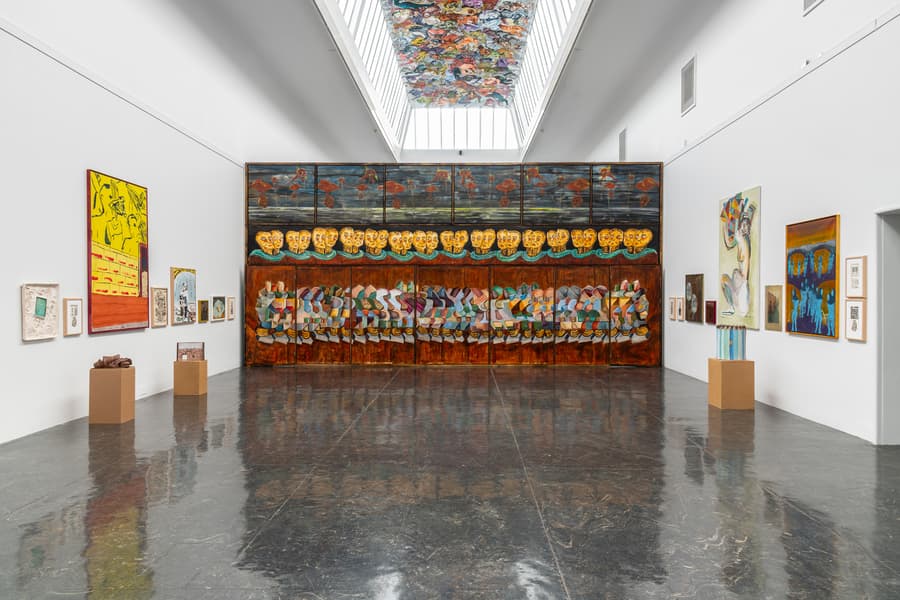Engebret, Enger, Jynge, Strømme, Winge

In the late summer of 1935, Kunstnernes Hus showed a five-part exhibition with the artists Bjarne Engebret, Erling Enger, Gert Jynge, Olav Strømme and Sigurd Winge. A total of 236 works of art were exhibited in the techniques of oil painting, gouache, woodcut, pastel and drawing.
What these artists had in common was that they had all studied under Axel Revold at the Norwegian Academy of Fine Arts. They were also critical of the older generation's cultivation of French art, the so-called Matisse students, and their romantic depictions of Norwegian nature and peasant culture. The artists in this exhibition sought more realistic expressions for their own time, in which they cultivated modernity as it unfolded in urban environments and could best be read in industry and technological development.
About the artists
Bjarne Engebret (1905-1985) was a Norwegian painter educated at the Norwegian Academy of Fine Arts under Axel Revold. He painted with an intense use of color and his motifs contained a heavy-handed simplification with unshaded fields, which resulted in him being considered one of the most radical painters in Norway of his time. He was seemingly unconcerned with the social realism and tendencies of art that was popular at the time, but rather believed in painting as a surface that should be filled with decorative and expressive colors and shapes. Engebret took these ideas even further when, in 1935, he switched to abstract painting. At this exhibition in Kunstnernes Hus, Engebret showed a number of non-figurative works. He also worked as a teacher at a private painting school in Oslo for 20 years. He has several works in the National Museum.
Erling Enger (1899-1990) was a Norwegian painter educated at the state's craft and art industry school and the Norwegian Academy of Fine Arts in Oslo. He experimented a lot with different techniques and materials early in his artistic career, his style gradually becoming increasingly colorful and simplified before in 1934 he began a period of non-figurative painting. He is represented in the National Museum with several paintings, with motifs from Enebakk.
Gert Jynge (1904-1994) was a Norwegian painter, graphic artist and draftsman. His production mainly took place in the interwar period, i.e. from the mid-1920s until 1948, when, according to his own statement, he "gave up". He exhibited at the Autumn Exhibition for the last time in 1961. Jynge belonged to a group of artists who stood in opposition to the prevailing Norwegian, French-oriented art direction of which Henrik Sørensen was one of the leading representatives. Gert Jynge was later pronounced expressionist in his form. He has several drawings and paintings, as well as some graphics, in the National Museum's collection.
Olav Strømme (1909-1978) was a Norwegian painter, educated at Statens Håndverks- og kunstdustriskole and the Norwegian Academy of Fine Arts. Strømme has cemented himself as one of the central figures in Norwegian modernist art history in the 1930s, particularly through major works such as the Herring motifs, Byen and Sommerfugl over byen. But at the time, Strømme did not receive the same recognition and struggled with his relationship with the works from this time, whilst he experienced the years of war in the 1940s. After a new solo exhibition at Kunstnernes Hus in the 1960s, he gained a newfound position in the Norwegian art community and created a number of new major works, e.g. the decoration of Furuset metro station just before his death in 1978. Strømme has a total of 30 paintings in the collection at the National Museum.
Sigurd Winge (1909-1970) was a Norwegian painter, material artist and graphic artist, educated at the Norwegian Academy of Fine Arts. He is most recognized as a graphic artist and for having worked with monumental works of art that included unusual materials and made a clear break with the "fresco era" in Norwegian monumental art. He was active with several decorative works until his death. Winge has paintings in various materials and graphics at the National Museum.


